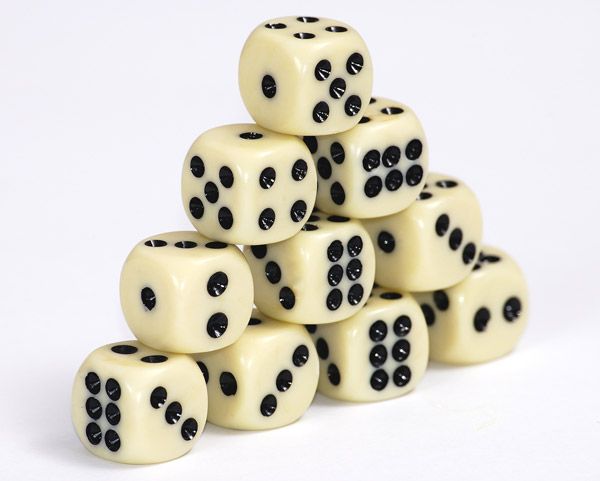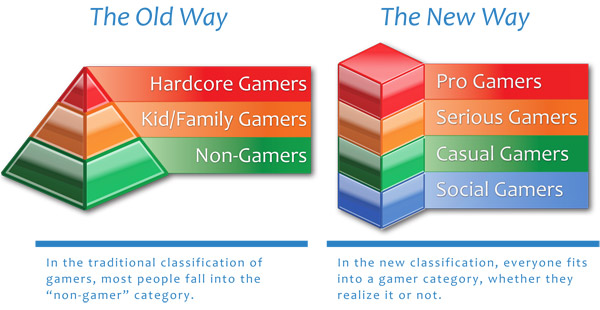Hierarchy of Gamers: Where Are the Lines Drawn?

In the tabletop gaming world, traditional standards classify the hierarchy of gamers loosely into "non-gamers," kids/family gamers, and hardcore/hobby gamers. This method of classifying gamers is at the foundation of existing marketing channels. Specifically, the toy industry promotes to kids/family gamers and the hobby game industry promotes to the hardcore gamers (see this article).
In reality, there is no such thing as a "non-gamer." People can say they are not gamers, but whether they admit it or not, everyone has played a tabletop game, video game, social game, or mobile game.
Unfortunately, because the industry caters directly to the family and hardcore gamers, casual gamers and others are often left out. Therefore, a new hierarchy needs to be defined, one where today’s many different types of gamers are better represented.
Where are the lines formed between the different types of gamers? The best determining factor becomes the time invested in gaming. Most people do not think about the time they spend playing games, but across the board it takes time to A) learn a game; B) play a game; C) set up a game (as simple as opening a box or complicated as mapping out a quest); and D) formulate strategies when the game is not being played. With this in mind, tabletop gamers can be classified into four main categories:
Social gamers — Social gamers do not make specific time to play games. They will play games if someone else is playing, has set up the game and needs them to play. They play with other family members on holidays, vacations or rainy days. When people are already gathered together in a social setting, playing a game becomes a "filler" activity to pass the time. Social gamers prefer games that do not require a lot of time or complicated strategy.
Casual gamers — Casual gamers want to gather people together to play games. They could easily spend an hour on a game, play multiple games in a night and are willing to play together a few times each month. They typically enjoy lightly strategic games or fun party games.
Serious gamers — Serious gamers are competitive and are willing to spend two or more hours on a single game. They always want to play games and think about gaming often. Serious gamers may be willing to play lighter games at times, but prefer games that require heavier tactics than the casual gamer typically prefers.
Pro gamers — These gamers are passionate about gaming and spend the greatest amount of time on it. They can easily spend hours organizing events around games, preparing for games or thinking about strategies. They can spend over 3 hours on a single game, multiple times a week. They often feel that there is not enough time in the week to game. They play the most complicated games and enjoy games that are heavy with strategy.

For too long, the tabletop gaming industry has failed to take notice that there are more than just Uno gamers and Arkham Horror gamers. The industry needs to take all types of gamers into consideration. Failing to do so will cause them to lose out on a significant demographic of casual gaming customers.
Casual Gamers: Unite!
Pushing forward through old stereotypes will not be easy, and casual gamers must band together to form a united front. They must speak out against the old mindsets with their voices as well as their wallets. Over time, blurred lines will start to move into focus. Gamers need to recognize and appreciate their differences before casual gamers can tackle the next step: gaining respect from other gamers.
In the hierarchy of gamers there is dissension among the ranks. Gamers at the top of the hierarchy look down on the bottom rungs. Some go so far as to refuse to play with gamers from different levels. This negativity is typically aimed at newer gamers or gamers at the social or casual levels. It suggests that the different classifications of gamers are merely a stepping stone to the next "level up."
Casual tabletop gamers are often seen as the tweens of the gaming world. Jim Sterling directly noted the "hatred of the casual [video] gamer" in "Casual Gamers Are Better Than You." In the tabletop realm, pro gamers may view casual gamers as not willing to put in the time and effort to play a game such as Arkham Horror, which can last for hours. This causes casual gamers to feel ostracized from other gamers.
Casual gamers need to branch out of their comfort zones to meet new gamers and make friends at every level. This can be done by joining or starting a board game club. A pro gamer may not always want to join in on a casual game session, but it’s always important to be friendly and say "hello." After awhile, a mutual respect will develop and common ground will be discovered. Casual gamers should help serious and pro gamers realize the merits of casual games through play. Over time, gamers will witness casual gamers’ commitment to gaming and will recognize them for the gamers they are.

Friendly local game stores (FLGS) are a great place to meet other gamers, and even some larger stores like Barnes and Noble offer an expanded game section in which it’s possible to bump into a new gamer in the making. Websites such as
BoardGameGeek.com or BoardGaming.com have a plethora of information on local gaming groups, game releases, and reviews from many different kinds of gamers. CasualGameRevolution.com is also gathering a community of casual gamers that share similar interests. Regardless of the means, casual gamers need to have a stronger voice in the gaming community.
There are many wonderful opportunities to be found in the casual game movement. We need to utilize the social aspect of gaming we love to celebrate the diversity of all gamers as we gather around the table.





